Few coffee-producing countries go the extra mile to protect their agricultural workforce like Costa Rica does. After a violent civil war in 1948, the newly-formed Constitutional Assembly abolished the military. This move reallocated Costa Rica’s budget to medical care and education, propelling the country into a period of peace and growth to this day.
“Costa Rica had a solidified universal health system since the 1940s and a big budget dedicated to education. That gave us a higher education level compared to most Latin American countries and is the basis for social equality and environmental conservation,” says Rafa Hernandez, General Manager of Volcafe Costa Rica, Genuine Origin’s sister company and sourcing partner in the region.
Country-wide dedication to social and environmental responsibility sets Costa Rican coffee apart from the crowd. At the core of the Costa Rican lifestyle is Purda Vida, a “don’t worry, be happy” attitude that revolves around positivity and gratitude, which extends to an appreciation for the country’s incredible biodiversity.
Costa Rica is tiny — only around a third of the size of Louisiana — yet 25% of the land is protected, and nearly 60% is reforested. Petroleum extraction and gold mining are banned here. The country also pivoted from having one of the highest rates of deforestation in the 1970s to completely stopping and reversing deforestation activity since 1996 through a government scheme promoting payments for ecosystem services (PES).
As one of the happiest countries on Earth, it comes as no surprise that Costa Ricans value quality over quantity — a mindset that’s woven into the coffee value chain from the very beginning. It’s the only country in the world to measure and buy coffee cherries in fanega, a unit of volume rather than weight. “This encourages pickers to choose the ripest cherries because riper is bigger,” says Hernandez.
Volcafe Costa Rica
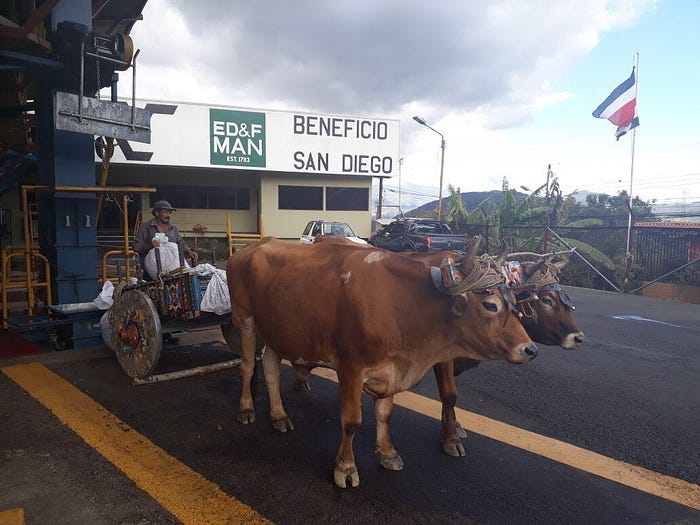
Coffee delivered by oxen to San Diego Mill
Volcafe Costa Rica’s Beneficio San Diego wet mill is the largest private mill in the country. Since 1888, the mill has pioneered constant innovations to process coffee from the Tarrazú region, an area affectionately referred to as the country’s nursery for great coffee. Over 2,000 small producers entrust their coffee to the mill, which spares no effort to maintain the high quality of coffee cherries delivered to respect the work of the farmers.
The surge in demand for micro-lots led to the birth of the Beneficio Anonos micro mill in the same region, giving Volcafe Costa Rica more leverage in efficiency and flexibility to maintain quality for micro-lots. With three more wet mills to the north and south, plus a dry mill where all coffee is prepped for export, Volcafe Costa Rica is present throughout the country’s coffee-producing regions to support farmers and continue driving innovation in the industry.
Receiving coffee in cherry is tricky but well worth the effort. Volcafe Costa Rica has 63 receiving stations in Tarrazú, 34 in Santo Domingo, and 50 in Perez Zeledon (with 5 in the Paramo region alone) to get as close to the farmers as possible. Cherry has a considerable advantage over parchment. It enables mills to homogenize quality and is essential for boutique processes like anaerobic fermentation.
Country-wide Production of Specialty Coffee
Costa Rica’s territory is influenced by the Pacific and Atlantic oceans, allowing coffee with different profiles to grow among eight producing regions. The terroir alone keeps Costa Rican coffee interesting, but coffee farmers and exporters don’t stop there.
“Part of what Volcafe Costa Rica brings to the table through sourcing [other than the best coffees in Costa Rica] are options that are unique and exotic while maintaining an attractive price for the buyer. We know our partner roasters also have a tough business to run, and there always has to be a dynamic,” says Hernandez.

Coffee farm in Paramo
Costa Rica’s quality socio-economic infrastructure contributes to the high cost of coffee. When coffee roasters buy Costa Rican green coffee, producers receive nearly 80% of the FOB value, guaranteed. Agriculture is heavily regulated with transparent minimum wages and sustainability practices, and the Instituto del Café de Costa Rica (ICAFE) goes to great lengths to ensure fair treatment along the supply chain.
For these reasons, green coffee from Costa Rica is — by default — more expensive than coffee from neighboring Central American countries. However, exporters like Volcafe Costa Rica have made it their mission to turn this disadvantage around with justifiable value. One of these commodities is the Laurina varietal, which was brought to Costa Rica approximately 15 years ago from Brazil.
Laurina is naturally low in caffeine, making it an attractive alternative to decaf processed coffee but it is challenging to grow. Due to its low pest resistance Laurina came to the brink of extinction, but has since become prized by roasters and had a resurgence in popularity. “Production is super scarce in Costa Rica because it’s also a low-yielding variety, but its biggest attraction is that it not only provides a nice Arabica cup profile with low caffeine but also scores highly at 85+,” says Hernandez. Lots of La Laurina will return to Genuine Origin this year, but this in-demand varietal tends to sell out fast.
“We’re also very proud of being a producing country with high coffee consumption ourselves,” says Hernandez. There are currently 63 local registered roasters, and Costa Ricans consume around 10 pounds of coffee per year per capita. While the specialty coffee sector is growing, a part of this coffee consumption is still heavily influenced by Costa Rica’s colonial heritage. Café Torrefacto is a local favorite, where sugar is roasted with green coffee and results in shiny, glazed beans with a distinct flavor.
Sustainable Specialty Coffee in the Field
Like other coffee origins, most of Costa Rica’s coffee farmers are aging rapidly. The country’s high standard of living, recent urban development, and comprehensive access to higher education makes coffee farming even less attractive for younger generations. The children of farmers are moving away from their family farms and into more lucrative careers.
“Costa Rica is an expensive country to live and farm coffee in. For farmers and future generations to be successful and stay interested, it has to be profitable,” says Riley Thomson, Farm Support Manager for Volcafe Costa Rica. “I’ve worked with farmers for 10 years to improve social and environmental practices, but over the last 5 years, we’ve changed our focus to implementing the Volcafe Way, which is really focused on the economic issues of the coffee business.”
The fieldwork includes transitioning coffee varieties, adjusting the distances between plants, and pruning plantations systematically every year. All of this is to help guarantee a profit margin for the farm that stays on a positive trend year after year.

Obata coffee nursery in Perez Zeledon
In the 1990s, Costa Rica peaked in coffee production at 35 quintals per hectare (around 3,500 pounds). Since then, however, production has reduced by nearly 40%. “We’re trying to help farmers produce more coffee like in the past but also reduce the cost per unit produced, so they make more money for every bag they sell,” says Thomson. “The traditional ways of farming weren’t business-focused.”
Carlos Sanchez, Volcafe Costa Rica’s Beneficio Dos Mil dry mill manager and a coffee farmer, has been working with Thomson to figure out the best recipe to manage his farm in the face of climate change. “As a farmer for any agricultural product, there are a lot of things you can’t control. But there are new coffee varietals that are more resistant to disease and more productive,” says Sanchez. “You can take that into consideration along with the density of how you farm and plant.”
Last year, Volcafe Costa Rica transformed its recreational soccer field at the El General Mill in the Perez Zeledon region into an Obata varietal coffee nursery. Obata is a hybrid of Caturra and a varietal that is native to Timor. The cup profile is similar to the Caturra but is much more resilient and sustainable, with high yields and better rust resistance. Obata is a short, stout plant with long branches making it easier to pick. Several thousand Obata plants will be distributed to area farmers when they reach maturity.
Volcafe Costa Rica recommends alternative varietals to farmers with three parameters in mind: pest and disease resistance, productivity levels, and overall cup quality. Because of Costa Rica’s high cost of production, farmers cannot afford to risk crop decimation due to disease. Volcafe Costa Rica sees the country’s staple Caturra variety fading from farms in the long term and replaced by new varietals that add to farming’s sustainability as a business.
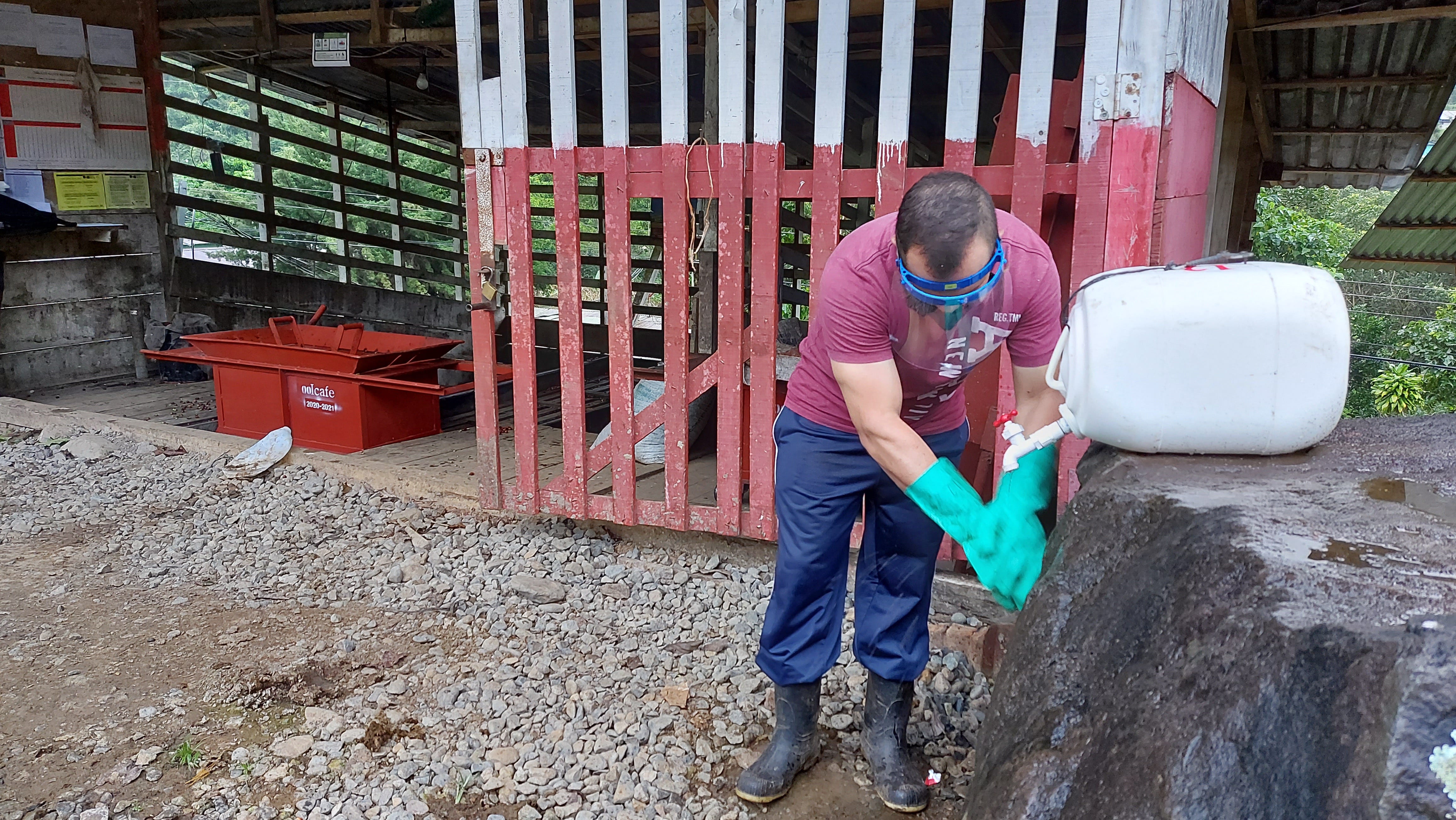
Portable handwashing station a coffee cherry drop off point
When COVID-19 first hit Costa Rica, Volcafe Costa Rica had to pause on-the-field support until they could develop new protocols. Small communities at high elevations above 1200masl like Paramo in Perez Zeledon were at risk of being completely cut off due to both the pandemic and hurricane weather. At the time, Volcafe Costa Rica made sure their partner roasters and customers were kept informed of the situation and devoted extra resources to harvest season logistics.
Costa Rica relies on migrant labor from neighboring countries like Panama and Nicaragua to help with coffee picking. Only around 20% of harvesters are Costa Rican. COVID-19 brought on enormous challenges for cross-border movement, however, and ICAFE jumped in to help find a solution. They saw an opportunity to mitigate COVID-19 unemployment with work opportunities on the farms and created an online registry for people to submit where they live and find out which farms they can help.
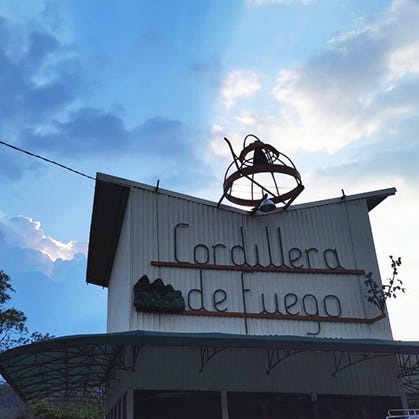
Cordillera de Fuego
“They called us to ask what our situation was and how many people we would need for the harvest,” says Sanchez. “It’s tricky though because Costa Ricans are not used to picking coffee, and people from neighboring countries are really good at it, but at the same time, we need to protect ourselves,” he says. Volcafe carried out a census to understand how many coffee pickers their partner farms needed. Together with the distribution of illustrated safety pamphlets and portable hand-washing stations for farms and cherry receiving stations without running water, the 2020 harvest went smoothly with very few COVID-19 cases.
As countries worldwide are experiencing yet another wave of infections, Costa Rica has remained stable, despite expecting another surge after the December holidays that never materialized. Vaccines are rolling out, albeit slowly, due to the country’s lack of freezers to store the doses.
Growing More Specialty: Always Ahead of the Curve
Costa Rica’s drive to differentiate solidified its position as an industry leader for coffee innovation. “In the 90s, we were the highest producing country in terms of farm productivity, but once that was a given, we had to differentiate through consistency. Then we switched to reducing our impact footprint in cherry to green coffee conversion,” shares Hernandez. In the early 2000s, Costa Rica lowered water consumption in the milling process to just one-tenth of what it was before. Now, the country is shining a spotlight on new processing methods.
Anaerobic coffees are still exotic — but growing in popularity. Fermenting coffee without oxygen is a temperamental process and requires a lot of experimentation to get it right. Ten years ago, one of Volcafe Costa Rica’s partner producers, don Luis Campos of Cordillera de Fuego, started anaerobic trials and has since perfected his methods.
“Five years ago [when Genuine Origin first started stocking his anaerobic coffee], we thought he was a little crazy with all of his experiments, but we bet on that project right from the beginning because we knew he was going to come up with something very unique,” says Hernandez. “Right when you were starting to fall in love with his perfected anaerobic process, he was coming up with the Termico process.” This is where heat is added to semi-washed beans to partially caramelize them, leaving a distinctly cinnamon flavor. “I’m sure this year don Luis is going to come up with something different and better — he’s always testing,” Hernandez adds.
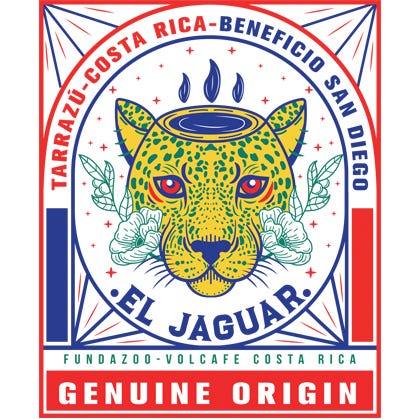
Tarrazu Jaguar Honey
Not all of the added value is industrial or agricultural. In 2010, Volcafe Costa Rica started the jaguar conservation project in partnership with Fundazoo. With every container sold of a partnering coffee like the Jaguar Natural or Jaguar Honey from the San Diego mill, around $1,200 is donated to Fundazoo’s preservation efforts (around $0.03/lb). The project has raised over $40,000 to conserve jaguars and wild cat habitats in Costa Rica. “This year, the project was dedicated to financing all the food for wild cats because, with COVID-19, zoos and conservation centers around the world are struggling to feed animals without proceeds from visitations,” says Max Gurdián, a Trader at Volcafe Costa Rica and a coffee farmer himself.
Genuine Origin & 2021 Costa Rica Green Coffee
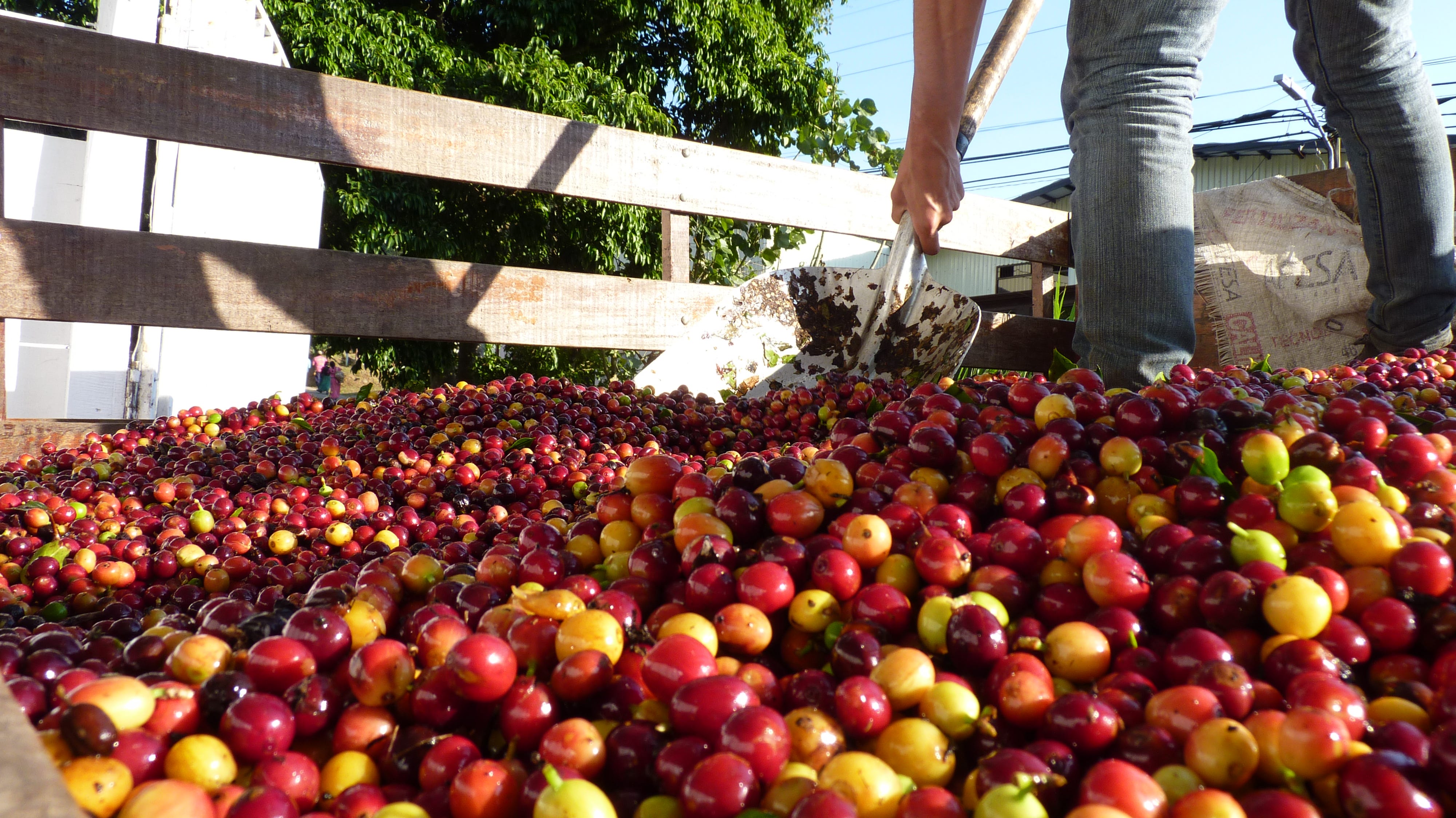
Delivering coffee cherry in Costa Rica
While it’s rare to find farmers in Costa Rica who only plant one varietal, Volcafe Costa Rica is prepared to sort single-variety lots to meet demand, especially for popular ones like Geisha and Yellow Catuai. Genuine Origin also expects more washed, natural, honey, anaerobic natural, termico, and assorted micro-lot coffees from the team at Volcafe Costa Rica.
Genuine Origin’s Costa Rica portfolio includes many high-altitude coffees, which require more time to mature. That’s why Genuine Origin sometimes receives shipments later than usual to allow enough time to create this coffee.
“Our Costa Rica program rocks and coffees tend to sell briskly,” says Rob Sulkow, Digital Marketing Manager at Genuine Origin. “Volcafe Costa Rica is constantly trying to raise the bar on excellence.”
There’s clearly no shortage of variety from this reputable coffee origin, and coffee roasters can continue to look forward to both stable consistency and brand new experiences in Genuine Origin’s Costa Rica portfolio. To learn more about Costa Rica and Volcafe Costa Rica, watch Genuine Origin’s Costa Rica Green Coffee Origin Report Webinar on YouTube.
###
Find out more about Genuine Origin’s Costa Rican coffee collection on our website — https://www.genuineorigin.com/costa-rica






